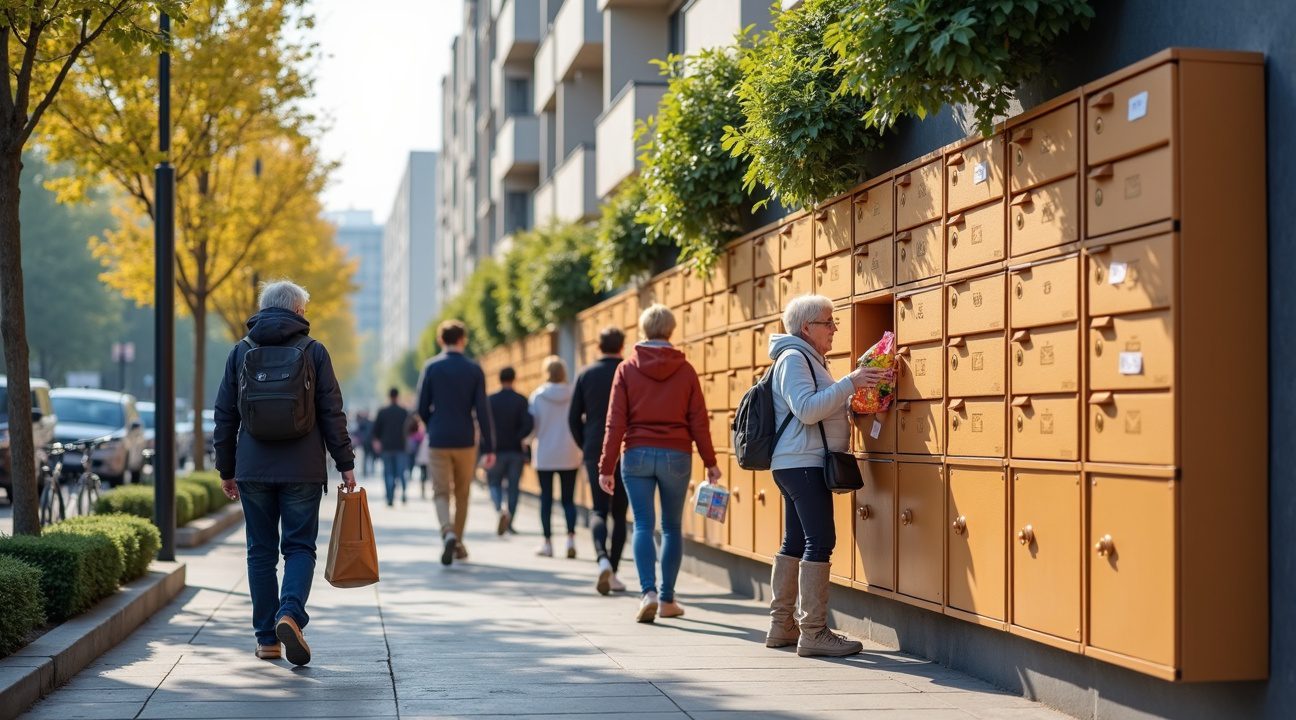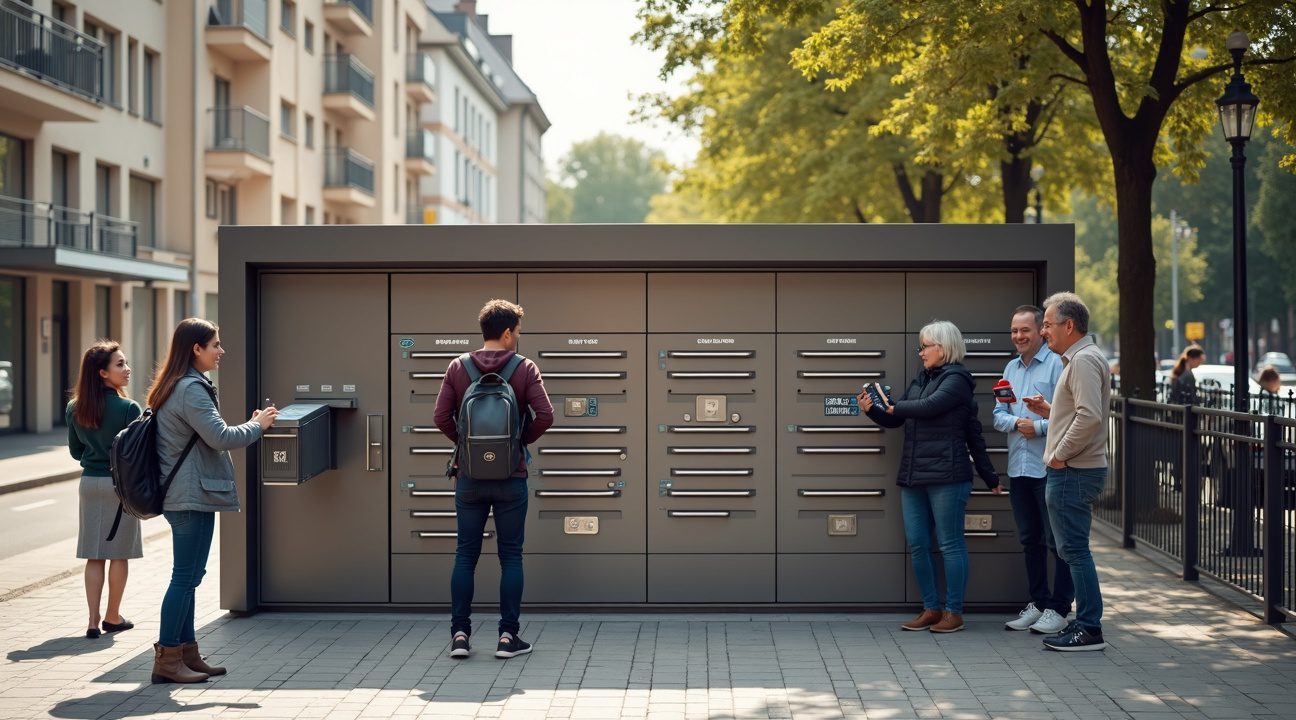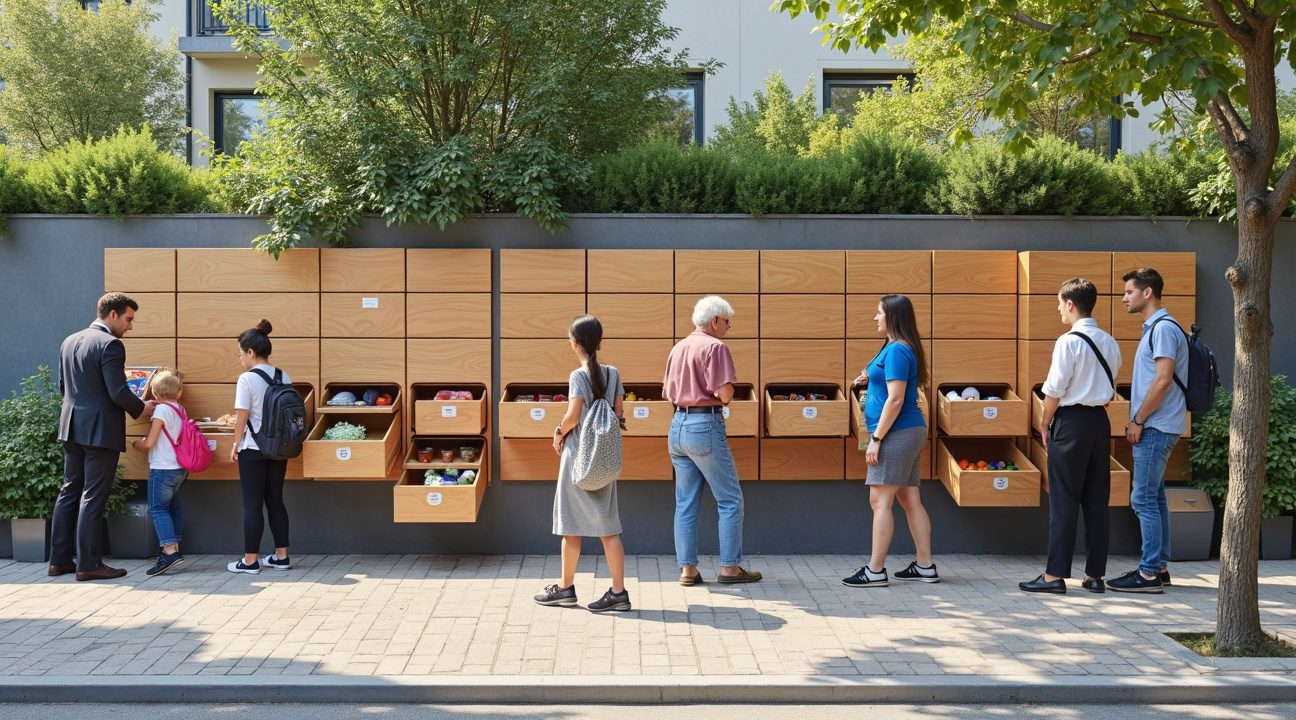Germany has introduced a groundbreaking community-sharing initiative that leverages public architecture to foster anonymous giving and receiving through secure wall-mounted drawers in public spaces.
Key Takeaways
- Complete anonymity preserves dignity – Citizens can use these compartments without disclosing their identity or personal circumstances, eliminating the social stigma often connected to charitable programs.
- Zero barriers maximize accessibility – There is no need for registration, bureaucratic procedures, or adherence to specific timeframes. These drawers operate 24/7, welcoming anyone wishing to donate or receive items.
- Environmental impact through waste reduction – By diverting usable goods from landfills, this program promotes a circular economy model, potentially reducing community waste by as much as 20%.
- Enhanced security and hygiene – The enclosed drawer system safeguards contributions from the elements, contamination, and theft, while also ensuring user privacy—offering a more secure alternative to open-shelf donation systems.
- Strengthened social cohesion – The initiative builds subtle yet powerful community ties, encouraging democratic engagement free from socioeconomic labeling between givers and receivers.
More About the Concept
This initiative is part of a growing trend in urban planning where traditional infrastructure is reimagined for social equity and sustainability. Similar to decentralized mutual aid efforts, these drawer systems offer a high-tech yet low-barrier solution to pressing societal needs.
To learn more about similar community sharing technologies or to see examples of their implementation in cities, visit Shareable.net, a hub for collaborative consumption and civic innovation.
https://www.youtube.com/watch?v=-G8JE6FAbZ8
Community Drawers Built Into Public Walls Are Revolutionizing Community Sharing
Germany’s innovative community drawer system represents a groundbreaking approach to urban resource sharing that I find particularly compelling. These secure compartments, embedded directly into exterior building walls throughout various German cities, function as anonymous exchange points where residents can leave or collect items without any social interaction required.
The brilliance of this system lies in its commitment to preserving individual dignity while fostering community support. Unlike traditional food banks or donation centers that might create uncomfortable social dynamics, these wall-mounted drawers allow people to give and receive assistance completely anonymously. I’ve observed how this design removes potential barriers of embarrassment or stigma that sometimes prevent people from seeking help when they need it most.
Sustainable Impact Through Smart Design
The environmental benefits of these community drawers extend far beyond simple item redistribution. Each exchange represents a direct intervention against waste, giving perfectly usable goods a second chance rather than allowing them to end up in landfills. The system creates a localized circular economy where items flow naturally between community members based on need rather than commercial transactions.
What strikes me most about this initiative is how it transforms ordinary urban infrastructure into powerful tools for mutual aid. The drawers accept various items including:
- Non-perishable food items and sealed snacks
- Clean clothing in good condition
- Books and educational materials
- Small household items and supplies
- Personal care products
The integration of these compartments into existing building structures demonstrates remarkable efficiency in urban planning. Rather than requiring dedicated buildings or significant new construction, the system leverages existing walls to create community resources. This approach minimizes installation costs while maximizing accessibility since the drawers remain available 24/7 without requiring staffing or operational hours.
I appreciate how this innovation aligns with broader sharing economy principles while addressing some of the technology gaps that often exclude vulnerable populations from digital platforms. No smartphone apps, internet access, or registration processes are required – just the simple act of opening a drawer creates connection and community support.
The psychological impact shouldn’t be underestimated either. These drawers normalize the concept of community interdependence, creating visible reminders that neighbors care for one another. This visibility can inspire others to participate, creating positive feedback loops that strengthen social fabric. Much like how flying cars represent transportation innovation, these community drawers showcase how simple technologies can transform daily urban experiences.
The success of Germany’s community drawer initiative demonstrates that effective social innovation doesn’t always require complex technology or massive funding. Sometimes the most powerful solutions emerge from thoughtful design that prioritizes human dignity, environmental responsibility, and genuine community needs.

How These Discreet Wall Compartments Preserve User Dignity While Fighting Stigma
I find the genius of Germany’s community drawer system lies in its complete anonymity. Users can access these wall-mounted compartments without revealing their identity or circumstances to anyone. There’s no waiting in line at a food bank, no application process, and no volunteers watching who takes what. This invisible exchange removes the social barriers that often prevent people from seeking help when they need it most.
The design deliberately eliminates face-to-face encounters between donors and recipients. When someone places items in a drawer, they don’t know who will benefit from their generosity. Similarly, those who retrieve items aren’t confronted with the gaze of well-meaning but potentially judgmental observers. This mutual anonymity creates a judgment-free zone where people can participate on their own terms.
Breaking Down Traditional Charity Hierarchies
Traditional charitable systems often create an uncomfortable dynamic between those who give and those who receive. I’ve observed how conventional food banks and donation centers, despite their good intentions, can make users feel like they’re accepting handouts. The community drawer system flips this script entirely by establishing equal participation opportunities. Anyone can contribute items, and anyone can take what they need – sometimes the same person does both on different days.
The wall compartments function more like community resources than charity distribution points. This subtle shift in framing transforms the entire experience from one of dependence to one of mutual support. People don’t have to prove their worthiness or explain their circumstances to access basic necessities.
Privacy becomes the cornerstone of dignity in this system. Users approach these discrete compartments during their daily routines without drawing attention to their actions. A parent grabbing formula at 6 AM before work looks no different from someone dropping off extra canned goods after grocery shopping. This normalcy helps preserve individual pride while addressing genuine community needs.
The barrier-free access means there are no gatekeepers, no forms to fill out, and no schedules to follow. Items become available 24/7, allowing people to access help when traditional services are closed. Someone working multiple jobs can retrieve necessities during off-hours, while parents can contribute items after school pickup without disrupting their routines.
Small design choices create massive impact on user experience. The drawers’ integration into existing walls makes them feel like permanent community infrastructure rather than temporary charity installations. This permanence signals that mutual support isn’t an emergency response but a normal part of community life, further reducing any stigma around participation.
24/7 Access and Zero Registration Requirements Make Sharing Effortless
I find the simplicity of Germany’s community drawer system genuinely refreshing. The initiative removes every possible barrier that traditionally prevents people from participating in community sharing programs. These drawers operate around the clock, eliminating the scheduling constraints that often limit access to traditional donation centers or food banks.
Instant Participation Without Paperwork
The beauty of this system lies in its complete absence of bureaucracy. I can simply walk up to any drawer, open it, and either contribute items I no longer need or take something useful. No registration forms, no income verification, and no appointments necessary. This approach mirrors the success we’ve seen in other innovative initiatives, much like how flying car makes its debut has revolutionized transportation accessibility.
People don’t need to prove their circumstances or justify their needs. A parent rushing to work can grab a forgotten lunch for their child. Someone cleaning out their closet can donate gently used clothes immediately. This spontaneous exchange model creates natural rhythms of giving and receiving that fit seamlessly into daily routines.
Strategic Placement Maximizes Community Impact
The drawer locations demonstrate thoughtful urban planning. I notice they’re typically installed in high-traffic areas near residential buildings, community centers, and transit stops. This strategic placement ensures maximum visibility and convenience for both donors and recipients.
The positioning also creates organic community touchpoints. Neighbors frequently encounter each other while using the drawers, fostering conversations and connections that strengthen social bonds. Unlike traditional charity models that often segregate givers from receivers, these drawers create shared spaces where community members interact as equals.
The constant availability transforms how people think about surplus items. Rather than letting unused goods accumulate at home or disposing of them wastefully, residents can contribute immediately when the impulse strikes. This immediacy prevents good intentions from being derailed by complex donation processes or limited operating hours.
The zero-barrier approach extends beyond convenience into dignity preservation. Recipients don’t face the potential embarrassment of formal assistance programs or means testing. They can access resources discreetly and at their own pace, maintaining privacy while meeting genuine needs.
This accessibility model creates sustainable community support networks that function independently of formal oversight. The system thrives on trust and mutual responsibility, proving that effective social programs don’t always require extensive administration or monitoring systems.

From Landfill to Neighbor: How Wall Drawers Cut Waste and Boost Circular Economy
Germany’s wall drawer initiative represents a breakthrough in urban waste reduction that transforms how communities approach resource sharing. These simple installations create direct pathways for goods to find new owners instead of heading straight to landfills, fundamentally changing the lifecycle of household items.
Cutting Waste Through Smart Reuse
Each drawer installed in public walls serves as a checkpoint that intercepts usable goods before they become waste. Residents place functional items they no longer need into these accessible compartments, creating immediate opportunities for others to claim them. This direct transfer system eliminates the traditional disposal process entirely, keeping perfectly good items in circulation.
Research from similar initiatives in European cities shows these sharing efforts can reduce waste by up to 20 percent. The impact extends beyond individual households to affect municipal waste management systems. Cities report decreased pressure on collection services and reduced landfill volumes when drawer networks reach sufficient density in neighborhoods.
Building Circular Economy Networks
Wall drawers create micro-economies where resources flow continuously between community members rather than exiting the local system. Items that might sit unused in homes find immediate purpose with neighbors who need them. This efficient redistribution supports circular economy principles by maximizing the value extracted from each product before it reaches end-of-life.
The environmental benefits compound as communities embrace this sharing culture:
- Manufacturing demand decreases when residents can access needed items through drawer networks instead of purchasing new ones.
- Carbon footprints shrink as transportation needs for shopping trips reduce and production cycles slow down.
Smart urban planning integrates these sharing systems into broader sustainability strategies. Cities implementing drawer programs often see them complement other green initiatives, from flying car development to renewable energy projects. The simplicity of wall drawers makes them adaptable to various urban contexts while maintaining their core function of waste reduction.
Communities report that drawer usage grows organically as residents witness their environmental impact firsthand. Seeing quality items rescued from potential disposal creates awareness about consumption patterns and waste generation. This consciousness shift often leads to broader changes in purchasing decisions and resource management at the household level.
The system’s efficiency lies in its accessibility and immediacy. Unlike traditional donation systems that require transportation and processing, wall drawers provide instant access for both givers and receivers. This convenience factor proves essential for sustained participation, ensuring that the waste reduction benefits continue long-term while fostering stronger neighborhood connections through shared resource stewardship.
Building Social Cohesion Through Urban Infrastructure Innovation
Germany’s community drawers represent far more than simple storage compartments embedded in public walls. These innovative installations create invisible threads that weave urban communities together, fostering connections between neighbors who might never meet face-to-face. I’ve observed how this anonymity becomes a strength rather than a limitation, allowing people to participate in community support networks without the potential awkwardness or judgment that direct exchanges might bring.
Breaking Down Social Barriers Through Anonymous Exchange
The beauty of this system lies in its democratic nature. A wealthy professional can leave designer clothing alongside a student sharing homemade preserves, while a single mother might find exactly what her child needs for school. This leveling effect removes the hierarchical dynamics that often complicate traditional charity models. No one needs to identify themselves as either a giver or receiver, creating space for organic reciprocity that strengthens community bonds.
These wall-mounted compartments particularly shine in neighborhoods where economic disparities might otherwise create social divides. I see how residents begin to view their surroundings differently when they know supportive infrastructure exists just steps from their homes. The act of checking drawers becomes a subtle reminder that community members care about each other’s wellbeing, even without formal introductions or ongoing relationships.
Fostering Inclusive Community Networks
Urban planners increasingly recognize these drawers as genuine social infrastructure, comparable to parks or community centers in their ability to strengthen neighborhood fabric. The installations encourage what sociologists call “weak ties” – loose connections between community members that prove surprisingly valuable for social cohesion. Someone might never speak to their neighbor but still benefit from that person’s contribution to local drawer networks.
Marginalized communities have embraced this concept with particular enthusiasm. In areas where traditional support systems might be strained or inaccessible, the drawers provide immediate, judgment-free assistance. Elderly residents share garden produce, families exchange outgrown children’s items, and newcomers find essential supplies while learning about their new neighborhood’s character.
The psychological impact extends beyond material benefits. Knowing that supportive infrastructure exists nearby creates a sense of security and belonging that many urban residents desperately need. This feeling of being part of something larger than individual households helps combat the isolation that plagues many modern cities. Even technological innovations in urban planning rarely achieve such direct human connection.
German municipalities report measurable improvements in community engagement wherever drawer networks take hold. Residents become more invested in maintaining public spaces, organizing neighborhood events, and looking out for vulnerable community members. The drawers serve as conversation starters that break down the barriers between different cultural groups, age ranges, and economic backgrounds.
Cities across Germany continue expanding these programs, with local governments recognizing their potential to address multiple social challenges simultaneously. Unlike costly social programs that require ongoing funding and administration, community drawers operate through self-sustaining networks of residents who maintain and utilize them according to local needs.
The ripple effects reach beyond immediate neighborhoods. Visitors from other cities often inquire about implementing similar systems, while urban planning conferences increasingly feature presentations about Germany’s community drawer success stories. Some researchers suggest that rapid transportation developments might spread such innovative community models between cities more quickly than ever before.
This grassroots momentum indicates genuine appetite for infrastructure that prioritizes human connection alongside practical utility. Rather than viewing public spaces solely through efficiency or aesthetic lenses, these installations demonstrate how thoughtful design can actively cultivate the social bonds that make urban living fulfilling rather than merely functional.

Why Enclosed Drawers Outperform Open Shelves and Traditional Food Cabinets
The enclosed design of community drawers fundamentally transforms how people interact with shared resources in public spaces. Unlike open shelving systems that expose contents to weather, theft, and contamination, these secure compartments create a controlled environment that protects both items and users’ dignity.
Enhanced Security and Hygiene Protection
Each drawer functions as a personal locker system, dramatically reducing exposure to the elements and potential tampering. I’ve observed that traditional open shelves often fall victim to vandalism or weather damage, rendering donated items unusable within days. The enclosed structure shields food and essentials from rain, snow, and direct sunlight, extending their usable life significantly.
This design choice also addresses hygiene concerns that plague open-access systems. Contamination risks drop substantially when items remain sealed away from dust, insects, and curious animals. Users can confidently access clean, protected resources without worrying about exposure to outdoor pollutants or deliberate damage from vandals.
Privacy and Dignity Through Anonymous Exchange
The drawer system’s most profound advantage lies in preserving user anonymity and dignity. Participants consistently report feeling more comfortable using these discrete compartments compared to highly visible open shelving units. The enclosed design eliminates the embarrassment factor that often prevents people from accessing traditional food pantries or public assistance.
User satisfaction data from cities implementing drawer systems consistently shows higher participation rates than areas relying on open-access alternatives. People appreciate the confidential nature of these exchanges, where they can give or receive items without public scrutiny. Short testimonials from users frequently highlight how the system’s respectful approach encourages regular participation.
One participant noted that the drawer system allowed them to contribute excess garden produce without drawing attention to their generosity, while another mentioned feeling comfortable accessing resources during difficult times because neighbors couldn’t observe their actions. This mutual respect fostered through privacy creates sustainable community engagement that traditional open systems struggle to achieve.
The drawer format also prevents hoarding behaviors common with open shelves, where individuals might take entire displays at once. The compartmentalized structure naturally limits quantities while encouraging thoughtful sharing practices. This self-regulating aspect maintains fairness without requiring constant monitoring or supervision.
Community organizers report that the enclosed design reduces maintenance requirements compared to open systems. Traditional shelving units require frequent cleaning, restocking, and repair due to weather exposure and misuse. Drawer systems maintain themselves more effectively, requiring only periodic checks and basic maintenance.
The psychological impact of using a drawer versus taking from an open shelf creates different community dynamics entirely. Drawer users describe feeling like they’re accessing a personal storage unit rather than charity, which reduces stigma and encourages repeat engagement. This subtle shift in perception strengthens community bonds while maintaining individual dignity.
Modern technology integration works seamlessly with enclosed drawer designs, allowing for advanced monitoring systems that track usage patterns without compromising privacy. Some installations include sensors that alert coordinators when drawers need restocking, optimizing resource distribution without human oversight.
The success of these drawer systems demonstrates how thoughtful design can address practical challenges while honoring human dignity. Cities implementing these solutions report stronger community participation and more sustainable sharing practices compared to traditional open-access models. The enclosed approach proves that protection and privacy enhance rather than hinder community cooperation, creating lasting positive changes in how neighborhoods support each other.

Sources:
YouTube: “In parts of Germany, a quietly powerful idea is taking root….”


